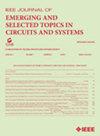Tempo-CIM:面向边缘人工智能应用的具有面积效率 LIF 神经元和分割-训练-合并-推理算法的 RRAM 内存计算神经形态加速器
IF 3.7
2区 工程技术
Q2 ENGINEERING, ELECTRICAL & ELECTRONIC
IEEE Journal on Emerging and Selected Topics in Circuits and Systems
Pub Date : 2023-10-02
DOI:10.1109/JETCAS.2023.3321107
引用次数: 0
摘要
与部署在传统冯-诺依曼架构上的人工神经网络(ANN)相比,基于尖峰神经网络(SNN)的内存计算(CIM)加速器为智能边缘设备提供了一种能效更高的前瞻性实施方案。然而,生物神经元昂贵的电路实现和离散脉冲网络不成熟的训练算法阻碍了高效的硬件实现和高识别率。在这项工作中,我们提出了一种 40nm RRAM CIM 宏(Tempo-CIM),该宏采用基于电荷泵的泄漏-整合-发射(LIF)神经元和分割-训练-合并-推理算法,可实现高效的 SNN 加速并提高准确率。采用单尖峰延迟编码来减少每个时间步中的脉冲数。电压型 LIF 神经元使用电荷泵结构实现高效积累,从而显著降低了对大电容的要求。此外,还提出了分割-训练-合并-推理算法,以动态调整每个神经元的输入,从而缓解尖峰失速问题。在 4b 输入和 8b 权重的情况下,宏的尺寸为 0.084 mm2,采用 40nm 工艺,能效为 68.51 TOPS/W,面积效率为 0.1956 TOPS/mm2。本文章由计算机程序翻译,如有差异,请以英文原文为准。
Tempo-CIM: A RRAM Compute-in-Memory Neuromorphic Accelerator With Area-Efficient LIF Neuron and Split-Train-Merged-Inference Algorithm for Edge AI Applications
Spiking neural network (SNN)-based compute-in-memory (CIM) accelerator provides a prospective implementation for intelligent edge devices with higher energy efficiency compared with artificial neural networks (ANN) deployed on conventional Von Neumann architectures. However, the costly circuit implementation of biological neurons and the immature training algorithm of discrete-pulse networks hinder efficient hardware implementation and high recognition rate. In this work, we present a 40nm RRAM CIM macro (Tempo-CIM) with charge-pump-based leaky-integrate-and-fire (LIF) neurons and split-train-merged-inference algorithm for efficient SNN acceleration with improved accuracy. The single-spike latency coding is employed to reduce the number of pulses in each time step. The voltage-type LIF neuron uses a charge pump structure to achieve efficient accumulation and thus reduce the requirement for large capacitance remarkably. The split-train-merged-inference algorithm is proposed to dynamically adjust the input of each neuron to alleviate the spike stall problem. The macro measures 0.084mm2 in a 40nm process with an energy efficiency of 68.51 TOPS/W and an area efficiency of 0.1956 TOPS/mm2 for 4b input and 8b weight.
求助全文
通过发布文献求助,成功后即可免费获取论文全文。
去求助
来源期刊

IEEE Journal on Emerging and Selected Topics in Circuits and Systems
ENGINEERING, ELECTRICAL & ELECTRONIC-
CiteScore
8.50
自引率
2.20%
发文量
86
期刊介绍:
The IEEE Journal on Emerging and Selected Topics in Circuits and Systems is published quarterly and solicits, with particular emphasis on emerging areas, special issues on topics that cover the entire scope of the IEEE Circuits and Systems (CAS) Society, namely the theory, analysis, design, tools, and implementation of circuits and systems, spanning their theoretical foundations, applications, and architectures for signal and information processing.
 求助内容:
求助内容: 应助结果提醒方式:
应助结果提醒方式:


